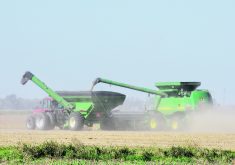The Environment Canada weather station in Deerwood, Man., recorded 78 millimetres of rain from May 1 to July 31.
Deerwood, near the town of Miami, is in south-central Manitoba.
In a more normal year, Deerwood would receive 200 mm of rain in May, June and July.
The lack of moisture explains the disappointing soybean yields in the central part of the province.
“Approximately 90 percent of soybeans have been harvested, with soybean yields mostly between 20 to 30 bushels per acre,” says the Manitoba Agriculture crop report for the central region.
Read Also

Huge Black Sea flax crop to provide stiff competition
Russia and Kazakhstan harvested huge flax crops and will be providing stiff competition in China and the EU.
That’s well below average for south-central Manitoba, where farmers typically target soybean yields in the 40s.
The results from central Manitoba are poor, but other parts of the province, such as the Parkland and eastern Manitoba, received more rainfall. Soybean yields in those regions are closer to 45 bu. per acre.
With the highs and lows, soybean yields should be close to average this year.
“Our five-year average is about 35 bu. per acre,” said Dennis Lange, the pulse crop and soybean specialist with Manitoba Agriculture.
“I’m kind of leaning towards about 34 right now (for the provincial average)…. That’s a projection. We don’t know for sure.”
Manitoba farmers planted more soybeans in 2023, partly because of strong yields in 2022.
Last year, soybeans posted a record 45 bu. per acre with some growers reaching 60 bu. per acre.
Acreage in the province climbed to 1.4 to 1.5 million, up from 900,000 in 2022.
However, rain mostly fell in the form of thunderstorms this summer, and too many acres were short on moisture.
“We’re not going to have a 45 bu. average,” Lange said.
“The weather has been variable. You can go to one field … and it got timely rains. I have a 60 bu. yield reported. You go down the road a few miles (where) it missed the rains, you’re down to 40. If you’re in the Carman area, then you’re in that 20 bu. range.”
Laura Schmidt, a production specialist with Manitoba Pulse & Soybean Growers, had a similar analysis.
“I don’t think I’m expecting a below average year…. There are a lot of good areas pulling up these averages.”
Rain had the largest influence on yield, but another form of precipitation was also a factor.
“(It was) hit or miss on who got hailstorms,” Schmidt said.
“Some of those hailstorms were very severe and definitely knocked back both yield and maturity. We are seeing quite a bit of late harvest, dealing with that maturity delay.”
Further east, in Ontario, soybean growers are looking at a year of strong yields.
Farmtario reported that growing conditions were optimal this summer and average yields are pegged at 53 bu. per acre. That’s up from the five year average of 49.2 bu. per acre.
It’s harder to peg yields in Saskatchewan because soybeans are a minor crop. From 2020-23, farmers in the province grew 40,000 to 100,000 acres of beans.


















